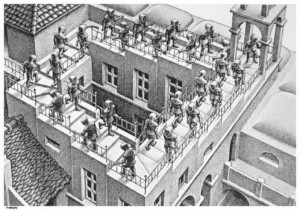AI in computer graphics
The issue of artificial intelligence for computer graphics is so important that, since 1994, first at 2 years and every year since 2002, is the European Conference „3IA International Conference on Computer Graphics and Artificial Intelligence”. Sample topics:
- artificial intelligence techniques in scene modeling,
- declarative techniques in scene modeling,
- artificial intelligence techniques in rendering,
- behavioural animation
- intelligent visualisation.
Examples of using artificial intelligence in computer graphics
1. Intelligent organization the scene and setting camera viewpoint on the scene..
This is a very complex issue which requires painting and directing genius of painting once (the problem of perspective), and now requires talent and experience of the designer. Even in the case of brilliant directors, this problem leads to a process of repeated recording of the scene, due to shortcomings on the scene or bad location of the camera.
2. Autocorrect object during editing.
To avoid later problems with the rendering and paradoxes, you must identify and correct the errors object. However, you should ask yourself, what is wrong and what is rational activity. Improving the image, often intentionally we introduce errors in logic and paradoxes to stimulate the mind and imagination of the viewer.
Interesting...
Impossible figure is a type of optical illusion consisting of a two-dimensional figure which is instantly and subconsciously interpreted by the visual system as representing a projection of a three-dimensional object although it is not geometrically possible for such an object to exist. One of the most famous creators of such figures was M. C. Escher.
Autocorrect of the object requires changing the data structures that describe the object. Currently these are the ruled surface or based on NURBS. Candidates for describing the structure of data objects are shape grammars. The description of the object must be such that it was impossible to create the requesting system, looking for contradictions in the object.
3. Predicting the next step the developer.
Predicting the next step the programmer that is detection of regularity in the scene, helps to speed up the work.
4. Artificial intelligence of a single animated object.
The synthesis movements system based on the specified destination path tries to build up a critical position. Then, based on the constraints type of collision and physical limitations, try to generate an intermediate position.
It uses the algorithm A*, well known in artificial intelligence.
A* uses a best-first search and finds a least-cost path from a given initial node to one goal node (out of one or more possible goals). It uses a distance-plus-cost heuristic function to determine the order in which the search visits nodes in the tree. The distance-plus-cost heuristic is a sum of two functions:
- g(x) – the path-cost function, which is the cost from the starting node to the current node,
- h(x)- an admissible ”heuristic estimate” of the distance to the goal.
so f(x) = g(x) + h(x)
This algorithm allows to take into account the cost of energy movement, its complexity, and allows us to predict further movement. However, there is the problem of optimality, because the aim of the move, we can accomplish in a few different ways, such as walking or running
Summary
Artificial intelligence in Modern Computer Graphics can be used in many different places and its significance will be grow rapidly due to increased computing power and development of multi-core processor technology.
Parent page: AI in computer graphics







